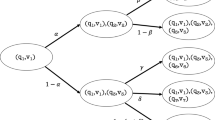Abstract
It is shown that a large class of continuous models for the average case analysis of many sorting algorithms (including quicksort, Shell's sort, heapsort insertion sort) will display the same expected behavior with respect to interchanges and comparisons. This is done by comparing these models with the discrete model in which every permutation has the same probability. Applications to priority queues and to straight insertion sort are given.
Zusammenfassung
Es wird gezeigt, daß eine große Klasse von stetigen Modellen für die Analyse des durchschnittlichen Verhaltens vieler Sortieralgorithmen (unter anderen: Quicksort, Shellsort, Heapsort, Insertion-sort) im Hinblick auf Austausch- und Vergleichsoperationen das gleiche erwartete Verhalten ergibt. Dies geschieht durch Vergleich dieser Modelle mit dem diskreten Modell gleichwahrscheinlicher Permutationen. Anwendungen auf Prioritätswarteschlangen und auf Sortieren durch Einfügen werden gezeigt.
Similar content being viewed by others
References
Aho, A. V., Hopcroft, J. E., Ullman, J. D.: The design and analysis of computer algorithms. Reading, Mass.: Addison-Wesley 1974.
Beuerman, D.: Personal Communication.
Brown, M. R.: Implementation and analysis of priority queue algorithms. SIAM J. Computing7, 298–319 (1978).
Doberkat, E. E.: Some observations on the average performance of heapsort. 21st IEEE FOCS, Syracuse, N.Y., 1980, pp. 229–237.
Doberkat, E. E.: Inserting a new element into a heap. BIT21, 255–269 (1981).
Doberkat, E. E.: Deleting the root of a heap. Acta Informatica17, 244–265 (1982).
Feller, W.: An introduction to probability theory and its applications, Vol. 1 (2nd ed.). New York: J. Wiley 1957.
Feller, W.: An introduction to probability theory and its applications, Vol. II. New York: J. Wiley 1966.
Knuth, D. E.: The art of computer programming, Vol. I: fundamental algorithms (2nd ed.). Reading, Mass.: Addison-Wesley 1973.
Knuth, D. E.: The art of computer programming, Vol. III: sorting and searching. Reading, Mass.: Addison-Wesley 1973.
Knuth, D. E.: Deletions that preserve randomness IEEE Trans. Softw. Eng.SE-3, 351–359 (1977).
Porter, T., Simon, I.: Random insertion into a priority queue structure. IEEE Trans. Softw. Eng.SE-1, 292–298 (1975).
Press, S. J.: Applied multivariate analysis. New York: Holt, Rinehart and Winston 1972.
Ramshaw, L.H.: Formalizing the analysis of algorithms. Technical Report, STAN-CS-79-741, Computer Science Dept., Stanford University Stanford, 1979.
Rudin, W.: Real and complex analysis, 2nd ed. New York: McGraw-Hill 1974.
Author information
Authors and Affiliations
Rights and permissions
About this article
Cite this article
Doberkat, E.E. Continuous models that are equivalent to randomness for the analysis of many sorting algorithms. Computing 31, 11–31 (1983). https://doi.org/10.1007/BF02247934
Received:
Issue Date:
DOI: https://doi.org/10.1007/BF02247934




